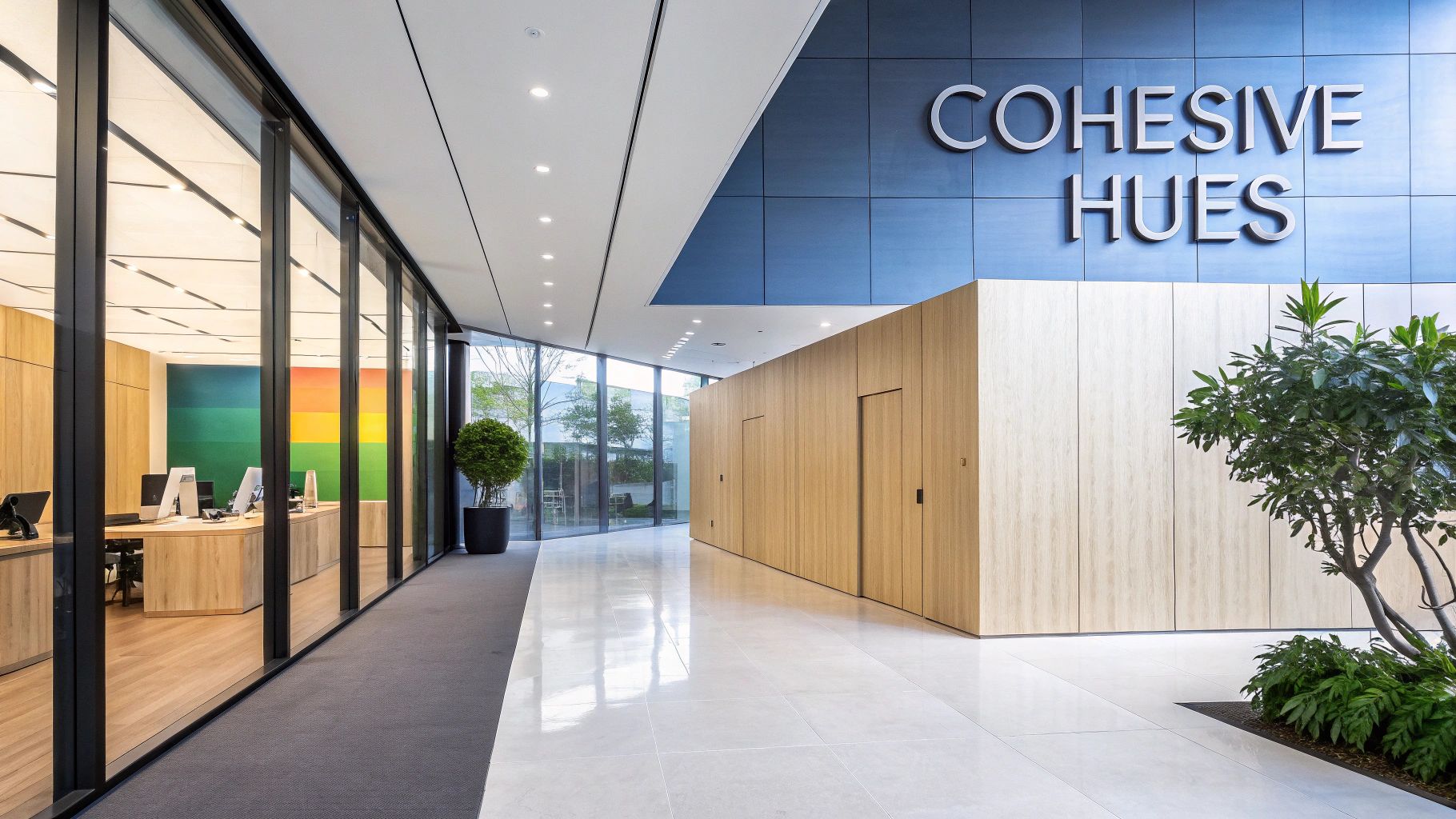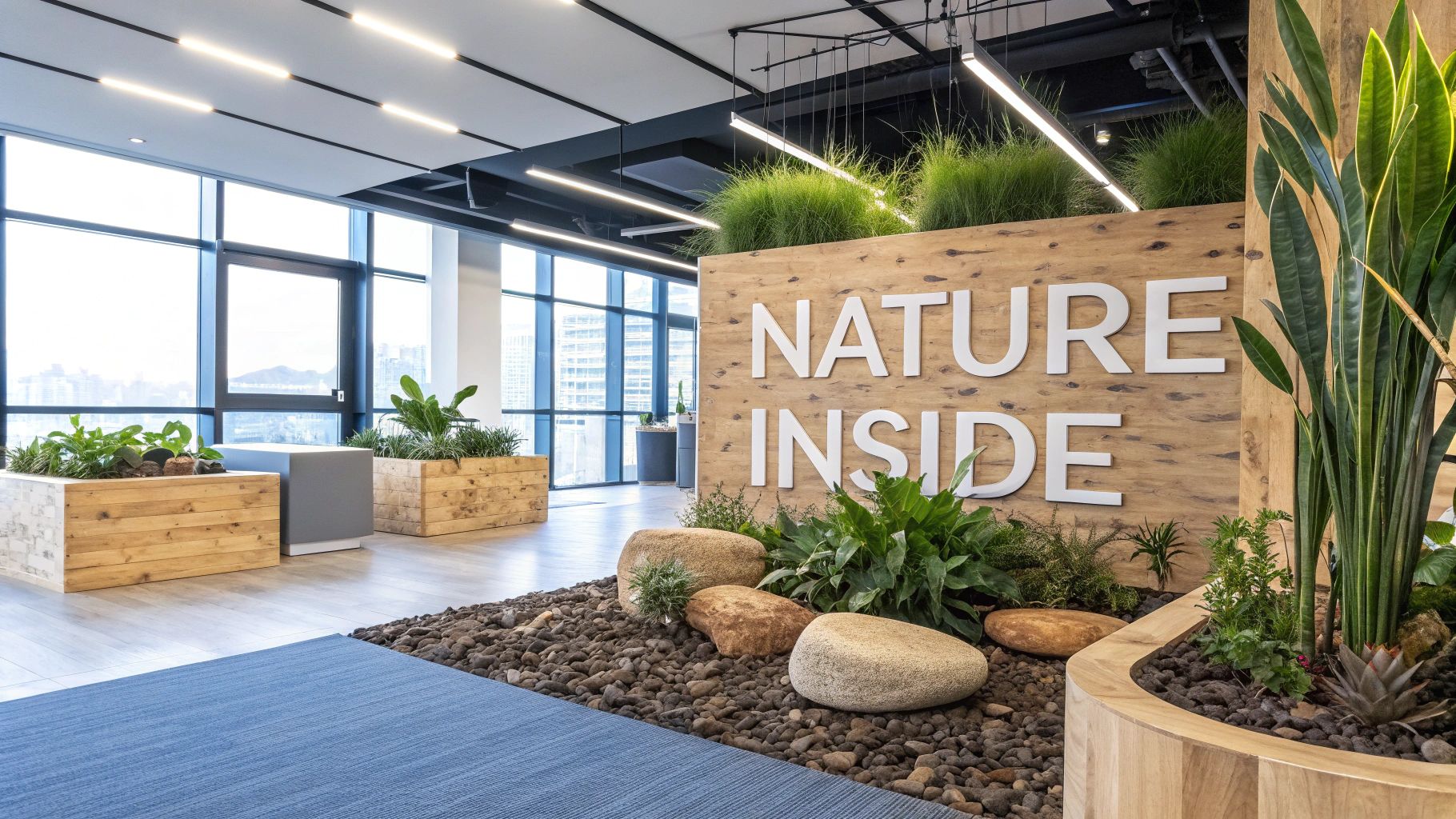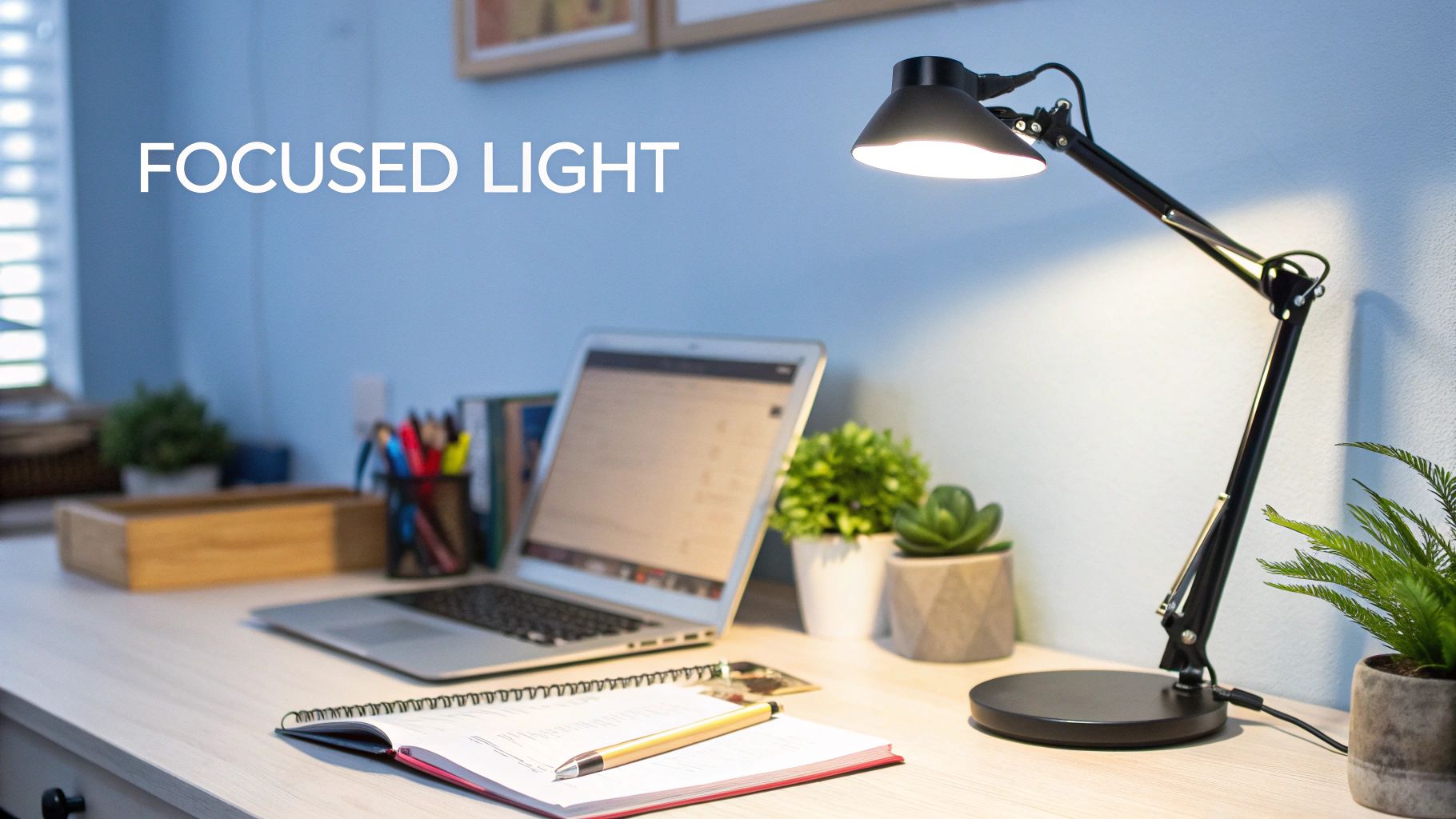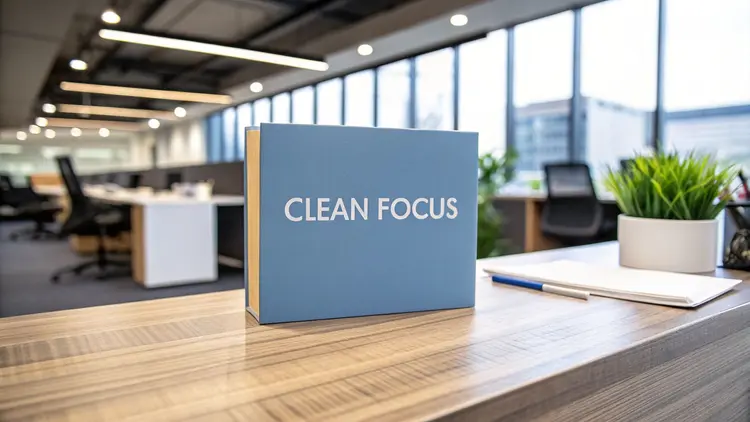Feeling overwhelmed by clutter and distractions in your workspace? Is your focus constantly drifting, making it tough to stay productive? You’re definitely not alone. A cluttered workspace often leads to a cluttered mind, especially in our demanding world. But what if a simple solution could reclaim your focus and boost your productivity?
Minimalist office decor isn’t just a stylish trend; it’s a powerful tool for creating a workspace that helps you do your best work.
The idea of “less is more” has influenced design and productivity for decades, from the clean lines of Bauhaus design to the Zen principles of Japanese minimalism. Its effectiveness lies in minimizing distractions and maximizing intention. Removing the unnecessary creates space for what truly matters: your work, your creativity, and your focus. A minimalist approach is especially valuable for entrepreneurs with ADD, solopreneurs juggling multiple tasks, content creators dealing with digital overload, and anyone looking for practical productivity tips.
This article will explore the key principles and practical strategies for designing a minimalist office that fuels your productivity.
Core Elements of a Minimalist Office
We’ll dive into the core elements that contribute to a truly effective minimalist workspace:
- Color Palettes: Discover how calming colors can create a serene and focused environment.
- Furniture Choices: Learn how selecting functional and aesthetically pleasing pieces can maximize space and minimize visual clutter.
- Lighting and Sound Management: Explore the impact of proper lighting and noise control on concentration and productivity.
Get ready to discover how embracing simplicity can transform your office into a haven of efficiency and inspiration, helping you conquer your to-do list and achieve your goals with newfound clarity.
1. Monochromatic Color Scheme
A monochromatic color scheme is a fantastic starting point for a minimalist looking to create a calm and productive office. This design approach uses different shades, tints, and tones of one color to build a cohesive and harmonious workspace. Imagine an office free of clashing colors, where everything contributes to a sense of peaceful focus. That’s the power of a monochromatic palette—perfect for minimalist offices where simplicity is key.

This strategy doesn’t restrict you to a single, flat hue. Instead, it explores the richness within a single color family. Think subtle transitions from deep charcoal to soft dove gray, or a range of warm beige tones adding depth and visual interest. Whites, blacks, and grays often serve as the base colors, offering a neutral backdrop for layering other shades. Adding different textures, like a textured wool throw on a smooth leather chair, prevents monotony and keeps things interesting.
Benefits of a Monochromatic Color Scheme
A monochromatic color scheme offers several advantages:
- Visually Calming: It reduces cognitive load, allowing you to focus on your work, not the decor.
- Simplified Decision-Making: Choosing furniture and accessories is easier when everything coordinates within your chosen color family.
- Timeless Aesthetic: This design approach rarely looks outdated.
- Enhanced Space Perception: Monochromatic schemes can make smaller offices appear larger and more unified.
Potential Drawbacks
While generally beneficial, there are potential downsides to consider:
- Cold or Sterile Feel: Without careful planning, a monochromatic space can feel impersonal.
- Lack of Visual Interest: Poor execution can result in a bland and uninspiring look. Integrating various textures is essential to avoid this.
Real-World Examples
Many companies utilize monochromatic design principles effectively. Think of the sleek white/gray aesthetic of Apple headquarters’ meeting rooms, or the warm beige tones of Kinfolk magazine’s Copenhagen offices. Even Muji’s corporate offices, with their natural wood and neutral palettes, showcase this principle. These examples demonstrate the versatility of monochromatic design.
For a deeper dive into the impact of color on office design, check out this article: How Colors Impact Office Design.
Design Influences and Tips
This trend draws inspiration from the “less is more” philosophy of Dieter Rams and the minimalist aesthetics of Scandinavian design firms like Norm Architects. Japanese minimalism, influenced by architects like Tadao Ando, also embraces the tranquility of monochromatic spaces.
To implement this in your own office:
- Incorporate Different Textures: Combine smooth and rough surfaces, matte and gloss finishes, and hard and soft materials within your chosen color family.
- Use at Least Three Shades: This adds depth and prevents a flat look.
- Add Small Pops of a Complementary Color: Introduce subtle contrast without disrupting the overall harmony.
- Consider Lighting Conditions: Darker colors might feel overwhelming in dimly lit rooms, while lighter colors can appear washed out in bright spaces.
By using a monochromatic color scheme, you’re not just decorating – you’re creating a focused, productive, and aesthetically pleasing environment that enhances your work and well-being. It’s a cornerstone of minimalist office design.
2. Floating Desk Setups
Floating desks are the perfect example of minimalist office style. These wall-mounted marvels eliminate bulky legs and pedestals, creating a spacious and airy workspace that’s difficult to achieve with traditional furniture. They’re a core component of minimalist office design because they reduce visual clutter while providing a practical work surface. This approach maximizes floor space, making them ideal for smaller offices or apartments where space is at a premium.https://www.youtube.com/embed/0T7uVRL0A4I
Their wall-mounted design, which often includes hidden cable management, contributes to a clean, uncluttered look beneath the workspace. This enhances the feeling of openness. It also makes cleaning much easier – no more struggling to reach dust under desk legs! Floating desks can also be custom-sized, allowing you to tailor your workspace to your exact needs and the size of your room.
Examples of Floating Desks
From IKEA‘s adaptable BJURSTA wall-mounted drop-leaf tables (easily repurposed as desks) to custom walnut pieces like those found in the Squarespace NYC headquarters, and even the minimalist birch plywood workstations of WorkOf design studio, the floating desk trend works across different budgets and styles. This versatility is a key reason for their popularity in minimalist office decor.
The floating desk concept gained popularity thanks to influential figures like Danish furniture designer Poul Cadovius, known for his modular wall-mounted shelving systems, and Japanese architectural firm SANAA, known for their minimalist aesthetic. Companies like Herman Miller further popularized the style with their minimalist office solutions, solidifying the floating desk as a modern design staple.
Considering the Drawbacks
While floating desks offer many advantages, it’s important to consider potential downsides. They typically have a lower weight capacity than traditional desks, so think carefully about what you plan to put on them. Proper installation is critical, and they aren’t suitable for all wall types. The lack of drawers means less built-in storage, requiring creative storage solutions. Their fixed installation makes rearranging your office layout harder.
Tips for a Successful Floating Desk Setup
To get the most from your floating desk setup, consider these tips:
- Install the desk at 29-30 inches from the floor for comfortable ergonomics.
- Use strong wall anchors rated for at least twice the expected weight of the desk and its contents.
- Install cable management systems to keep wires organized and hidden.
- Add a slim, wall-mounted drawer or shelf underneath for extra storage.
- Check out our guide on Home Office Organization Tips for ideas on maximizing workspace efficiency.
By considering the pros and cons and using these practical tips, you can successfully add a floating desk to your minimalist office. Enjoy the benefits of increased space, a light, airy feel, and improved productivity.
3. Integrated Cable Management
In a minimalist office, visual peace is paramount. There’s nothing quite as disruptive to that calm feeling as a tangled mess of cords and cables. That’s where integrated cable management comes in, a core element of minimalist office design. It goes beyond just aesthetics; it’s about a workspace that encourages focus and productivity. This is especially valuable for entrepreneurs with ADD, solopreneurs, content creators, and anyone looking to boost their productivity.
Integrated cable management systems essentially make your tech disappear. Think hidden channels and raceways, desk grommets, built-in wire organizers, cable sleeves, and using wireless technology whenever you can. These systems hide the digital “veins” of your office, creating clean lines and uncluttered surfaces.
Imagine a workspace free from visual distractions. No more hunting for the right cable or tripping hazards – just pure focus. That’s the power of integrated cable management. It streamlines your physical environment, leading to a clearer mind and more productive work.
Features and Benefits
Here’s a closer look at how these systems work:
- Hidden Channels & Raceways: These discreetly guide cables behind walls, under desks, and through furniture, effectively hiding them from view.
- Desk Grommets & Built-in Organizers: Desk grommets provide elegant exit points for cables, and built-in organizers keep them tidy and within easy reach.
- Cable Sleeves & Cord Collectors: These helpful tools group cables together, minimizing visual clutter and preventing tangles.
- Wireless Tech Integration: Opting for wireless keyboards, mice, printers, and charging solutions minimizes visible cables.
Pros and Cons
Like anything, integrated cable management has its advantages and drawbacks. Let’s break them down:
| Pros | Cons |
|---|---|
| Dramatically reduces visual noise | Difficult to modify after installation |
| Cleaner, more professional appearance | Professional installation sometimes needed |
| Prevents cable damage and improves safety | Limited furniture rearrangement options |
| Easier cleaning | Initial setup can be time-consuming |
Real-World Examples
Looking for some inspiration? Check these out:
- BoConcept’s Copenhagen Desk: This sleek desk has a built-in compartment that keeps cords neatly out of sight.
- Steelcase’s Thread Power Distribution System: Thread provides an adaptable under-carpet power solution, making access to power and data simple.
- Vitra’s Joyn Office System: This modular system includes integrated channels for cable routing, keeping your workspace organized and efficient.
Tips for Implementation
Ready to get started? Here are a few tips:
- Quick Fix: For a fast and easy solution, use adhesive-backed cord clips to organize visible cables.
- Labeling: Label your cables with heat-shrink tags before hiding them. Trust us, you’ll thank yourself later.
- Strategic Outlets: Installing power outlets in smart locations minimizes cord length and clutter.
- Matching Sleeves: For any cords that remain visible, consider using cable sleeves that match your office’s color scheme.
A Little History
The minimalist design principles behind integrated cable management can be traced back to influential figures like Dieter Rams, renowned for his work with Braun, and Apple’s Jonathan Ive. Herman Miller, a leader in ergonomic office solutions, has also played a key role in making integrated cable management a staple of modern offices.
By incorporating integrated cable management, you’re not just organizing your office – you’re creating a workspace that fosters focus, productivity, and a visually pleasing environment. It’s a small change that can make a big difference, aligning perfectly with the minimalist idea of achieving more with less.
4. Functional Minimalist Storage
A clutter-free workspace isn’t just visually appealing; it can actually boost your productivity. The key to achieving this zen-like workspace? Functional minimalist storage. This design philosophy lets you keep everything you need close at hand while maintaining a clean, uncluttered aesthetic. It emphasizes hidden storage, sleek lines, and furniture that serves double duty to create a serene and productive work environment. It’s an essential element for anyone looking to minimize distractions and streamline their workflow, especially entrepreneurs and content creators.

Think sleek cabinets with push-to-open doors, wall-mounted shelves with concealed brackets, or a stylish desk with built-in drawers. These solutions offer practical storage without cluttering your visual field. Multi-functional furniture, like an ottoman that doubles as storage, further maximizes space and minimizes visual distractions.
Digitizing your documents is another key component. By going paperless, you can significantly reduce the need for bulky filing cabinets and move towards a more digital office. You still have access to all your important files, just without the physical clutter. For a deeper dive into the benefits of minimizing your belongings, check out our article about the 12 Universal Benefits of Minimalism.
Pros of Functional Minimalist Storage
- Reduces visual and mental clutter: A clean workspace leads to a clear mind, improving focus and concentration.
- Encourages mindful organization: Minimalist storage prompts regular decluttering and thoughtful choices about what to keep.
- Creates open sightlines: This contributes to a sense of calm and makes even small workspaces feel larger.
- Minimizes visual distractions: Fewer visual stimuli mean fewer interruptions and a more productive work flow.
Cons of Functional Minimalist Storage
- Requires regular upkeep: “Out of sight, out of mind” can lead to clutter accumulating inside closed storage.
- May limit quick access: Some storage solutions prioritize aesthetics over easy access to frequently used items.
- Offers less overall storage: Minimalism encourages owning less, which naturally means needing less storage space.
- Can be expensive: High-quality minimalist furniture and storage can come with a hefty price tag.
Examples of Minimalist Storage Solutions
- USM Haller modular storage systems: Beloved by Swiss architecture firms for their sleek design and flexible configurations.
- Vitsœ 606 Universal Shelving System: Designed by Dieter Rams, this iconic shelving system epitomizes functional minimalism.
- IKEA Besta systems with minimal hardware: A budget-friendly way to create a minimalist look with personalized storage.
Tips for Implementing Minimalist Storage
- “Touch it once”: Handle papers and documents immediately to prevent piles from accumulating.
- Choose furniture with hidden compartments: Keep office supplies tucked away and out of sight.
- Use matching containers: Uniform containers inside cabinets create visual coherence and make it easier to find items.
- Digitize and organize documents: Create a consistent file-naming system for efficient retrieval in a paperless office.
Popularized By
The minimalist storage movement has gained traction thanks to influential figures like Marie Kondo and her KonMari Method, which encourages keeping only items that “spark joy.” Dieter Rams’ “less is more” philosophy, Scandinavian design companies like String Furniture, and Japanese minimalism with its focus on ‘ma’ (negative space) have also played significant roles in its popularity.
5. Biophilic Elements
Want a minimalist office that doesn’t feel cold and impersonal? Biophilic design is your answer. It beautifully blends the sleek lines of minimalism with the refreshing presence of nature, boosting both your space’s appearance and your overall well-being. This isn’t just about adding a random houseplant; it’s about crafting an environment that nourishes your mind and cultivates a sense of calm focus. It’s perfect for entrepreneurs, solopreneurs, content creators, and anyone looking to enhance productivity.

Biophilic design strategically introduces natural elements while staying true to the minimalist principle of “less is more.” Imagine eye-catching plants with interesting shapes, natural materials like wood and stone, and nature-inspired textures and patterns used thoughtfully. The goal is to establish a sensory connection with nature without creating clutter.
Features and Benefits
Here’s how you can bring the outdoors in:
- Statement Plants: A few well-chosen, large plants can make a visual impact and create a calming atmosphere without overwhelming the room.
- Natural Materials: Using wood, stone, linen, or leather introduces warmth and texture to your minimalist office.
- Subtle Textures & Patterns: Think a rug with a delicate leaf pattern or a wooden desk showcasing its natural grain. These small details add depth while preserving the clean aesthetic.
- Improved Air Quality & Well-being: Plants are natural air purifiers, making your work environment healthier and more conducive to productivity.
- Sensory Connection to Nature: Biophilic design helps reduce stress and improve focus by bringing the soothing effects of nature inside.
Pros & Cons
Like any design choice, biophilia has its advantages and disadvantages:
Pros:
- Improves air quality and boosts well-being
- Adds visual appeal without feeling cluttered
- Connects you with nature through your senses
- Softens the starkness that minimalist spaces can sometimes have
Cons:
- Plants need regular care and attention
- High-quality natural materials can be pricey
- Striking the right balance between minimalism and biophilia takes careful planning
- Changing seasons can impact lighting conditions for your plants
Real-World Inspiration
Big names like Airbnb, Slack, and Microsoft have all embraced biophilic design. Airbnb’s headquarters features strategically placed statement plants, while Slack incorporates built-in planters and natural wood. Microsoft’s treehouse meeting rooms are a striking example of sophisticated biophilic design. These companies show how biophilia fits seamlessly into even the most modern and minimalist settings.
Tips for Implementation
Here’s how to get started with biophilic design:
- Low-Maintenance Plants: Choose easy-to-care-for plants like snake plants or ZZ plants. They thrive even with minimal attention, which is perfect for busy entrepreneurs.
- Statement Pieces: Select one or two large, impactful plants instead of many small ones to avoid a cluttered look.
- Durable Materials: Invest in natural materials known for their durability, like oak or leather. These will age beautifully and add a touch of timeless elegance.
- Vertical Space: Use plant stands to create different levels and add visual interest without taking up valuable desk or floor space.
The Roots of Biophilia
The term “biophilia” comes from biologist E.O. Wilson. Since then, architects and designers like Kengo Kuma and Ilse Crawford have embraced the concept, advocating for nature-integrated minimalism and human-centered design. This growing trend reflects a larger shift toward workspaces that prioritize well-being and productivity.
Biophilic elements are a valuable addition to any minimalist office. They bridge the gap between stark simplicity and the vibrancy of nature, creating a workspace that’s both visually appealing and conducive to focused work. If you’re seeking a productive and inspiring environment, biophilia is a must.
6. Task-Focused Lighting
In the quest for a minimalist office, lighting sometimes takes a backseat. But great lighting is essential, not just so you can see, but for productivity and your overall well-being. This is where task-focused lighting shines. Instead of generic overhead lights, this approach uses strategically placed lights to illuminate specific work areas. This minimizes visual clutter and maximizes efficiency, perfectly embodying the minimalist “less is more” philosophy.
Task-focused lighting uses a variety of fixtures. Think adjustable desk lamps with slim profiles, integrated lighting within shelving or under cabinets, or pendant lights with simple geometric designs. Optimizing natural light with the right window treatments is also key. Sheer curtains, for instance, can soften harsh sunlight while still letting in plenty of natural light.
The benefits are numerous. Task-focused lighting can significantly improve work performance and focus by reducing eye strain. It also creates a visual hierarchy, highlighting important areas and minimizing distractions. This is especially helpful in open workspaces. Plus, by eliminating the need for lots of general lighting fixtures, it contributes to a cleaner, more streamlined look.
There are some things to consider, of course. High-quality task lighting can be an investment. Integrated solutions might require professional installation. Finding minimalist fixtures with great light output can take some research. And proper placement is essential to avoid glare on screens, which can defeat the purpose.
Real-world examples show how effective task-focused lighting can be. Artemide’s Tolomeo desk lamp, known for its adjustable arm and sleek design, has been featured in Facebook’s headquarters. Muuto’s Under The Bell pendant lights, with their simple yet striking shape, grace WeWork offices. And the classic Anglepoise Type 75 lamps are a staple in BBC production offices. These examples show how task-focused lighting blends function and minimalist design.
Influential figures like Scandinavian designers Poul Henningsen, known for his innovative lamp designs, have championed the concept of task-focused lighting. It also draws inspiration from architect Richard Meier’s studies on light quality and Japanese lighting designer Isamu Noguchi’s sculptural approach to lighting. Brands like Artemide, Flos, and Louis Poulsen continue to push the boundaries of minimalist lighting design.
Tips for Implementation
- Side Lighting: Position task lighting to the side, not directly overhead, to reduce glare.
- Adjustability: Choose adjustable fixtures to fit different tasks and times of day.
- Color Temperature: A neutral color temperature (around 4000K) is best for productivity.
- Layered Lighting: Combine ambient, task, and accent lighting for maximum flexibility and ambiance. You might be interested in: Our guide on top work-from-home productivity tips.
By following these tips and weighing the pros and cons, you can use task-focused lighting to create a minimalist office that is both beautiful and functional, boosting your productivity and well-being.
7. Multifunctional Furniture
In the pursuit of a minimalist office, less is definitely more.
But, minimizing your belongings doesn’t mean you have to sacrifice practicality. That’s where the beauty of multifunctional furniture comes in. These ingenious pieces often serve two or even three purposes, helping you maximize space and minimize clutter. It’s a win-win for anyone embracing minimalism, especially entrepreneurs, solo business owners, or content creators juggling multiple roles. This streamlined physical space can also do wonders for your mental clarity and focus, a real bonus for anyone with ADD or looking for productivity hacks.
Multifunctional furniture embraces minimalist design principles with its clean lines and simple forms, while simultaneously addressing practical workspace needs. Imagine replacing a separate desk, filing cabinet, and bookcase with a single, elegant piece incorporating all three. This not only frees up valuable floor space but also reduces visual distractions, allowing you to truly concentrate on your work.
Think of a desk that effortlessly transitions between sitting and standing, like the Fully Jarvis desk (popular at Shopify headquarters). Or perhaps a storage ottoman that doubles as extra seating for client meetings or brainstorming sessions. Modular systems, championed by designers like Joe Colombo, adapt to your evolving needs, offering flexibility for growing businesses or changing project demands. Even simple solutions like nesting tables or extendable surfaces can be tucked away when not needed, maintaining a clean, uncluttered aesthetic. BDI’s Sequel lift desk with built-in storage is a prime example of how form and function can beautifully coexist.
Benefits and Drawbacks of Multifunctional Furniture
The benefits of multifunctional furniture are numerous:
- Maximized functionality without increasing the number of items you own.
- Adaptability to changing work requirements.
- A smaller footprint for your office furnishings.
- A more flexible work environment.
Just imagine how much easier digital decluttering becomes when your physical space is already optimized!
However, it’s important to consider the potential downsides:
- Cost: Quality multifunctional pieces can be more expensive.
- Specialized Functionality: While versatile, they might sometimes slightly compromise on specialized features compared to dedicated single-purpose items.
- Durability: Complex mechanisms, like those found in transforming furniture, might be prone to issues over time.
- Size and Weight: Some multifunctional pieces can be heavier or larger than their single-purpose counterparts.
Tips For Choosing Multifunctional Furniture
- Prioritize Quality: Invest in sturdy mechanisms built to withstand regular use.
- Clean Lines: Choose pieces with sleek, minimalist aesthetics, even when extended or transformed.
- Neutral Finishes: Opt for colors and materials that complement various configurations and your existing décor.
- Test Ergonomics: Ensure comfort and functionality in all intended uses before purchasing.
The concept of multifunctional furniture isn’t new. Designers like Børge Mogensen, Joe Colombo, and Alvar Aalto pioneered transformable and multi-use systems decades ago. Today, brands like Vitra, Knoll, and Herman Miller continue to innovate, creating pieces that seamlessly blend form and function. The HAY’s Copenhague desk series, seen in Dropbox offices, exemplifies this evolution.
Multifunctional furniture is a perfect fit for any minimalist office. It embodies the essence of the philosophy: doing more with less. By carefully choosing pieces that serve multiple purposes, you can create a workspace that is not only visually appealing, but also highly efficient and adaptable to your ever-changing needs. This approach is ideal for entrepreneurs, productivity enthusiasts, minimalists, and anyone looking to improve their work life through smart design.
8. Negative Space Utilization
In today’s busy world, it might seem strange to focus on emptiness. But in minimalist office design, negative space is king. It’s the art of using empty areas as a powerful design element. This can be a game-changer for entrepreneurs with ADD, content creators fighting distractions, or anyone wanting a calm and productive workspace.
Negative space isn’t just about bare walls and empty desks. It’s about celebrating emptiness, creating visual breathing room that reduces mental clutter. Imagine a sparsely furnished room where furniture placement highlights the open areas. An asymmetrical arrangement creates a dynamic void, drawing the eye and promoting a sense of calm. Minimal wall decorations, spaced apart, allow each piece to stand out. Even empty surfaces become design elements, offering a visual break.
This approach offers many benefits. It creates calm and mental clarity, essential for those easily overwhelmed. It makes small spaces feel larger, a plus for solopreneurs or those working from home. By reducing visual stimulation and distractions, it promotes focus and productivity. And, because less is more, it emphasizes the quality of the few selected design elements.
This concept’s roots trace back to traditional Japanese architecture and the concept of ‘ma’ (間) — the space between objects, often as important as the objects themselves. Modernist architects like Tadao Ando and Ludwig Mies van der Rohe popularized negative space, creating iconic structures defined by simplicity and spaciousness. Think of John Pawson’s minimalist designs, the airy feel of Norm Architects’ Copenhagen office, or even the Apple Store’s minimalist displays. These demonstrate the power of negative space.
Of course, there are potential downsides. A sparsely decorated space can feel stark to some. Maintaining the emptiness takes discipline. A minimalist aesthetic may appear unfinished to those unfamiliar with the concept. High-quality materials become even more important, as architectural elements are more visible.
Tips for Implementing Negative Space
- Apply the ‘one in, one out’ rule: For every new item, remove an existing one. This prevents clutter.
- Create ‘pauses’ between functional areas: Don’t cram furniture. Leave space between your desk, filing cabinet, and meeting area.
- Use subtle textures: A textured rug, a woven wall hanging, or a natural wood desk can add warmth without clutter.
- Consider ‘ma’ (間): Think about the space between objects.
Negative space deserves its place on this list. It’s more than a trend; it’s a mindset shift. It’s about embracing simplicity and finding beauty in emptiness. For those seeking a calmer, more focused workspace, negative space can be transformative.
9. Acoustic Minimalism: Finding Focus in a Quiet Space
In a minimalist office, less is often more. But sometimes, when it comes to sound, too little can actually hinder productivity. That’s where acoustic minimalism comes in. This design approach focuses on sound quality, blending it with minimalist aesthetics for a workspace that’s both visually and aurally calming. It recognizes that a truly minimalist space considers all the senses, not just sight. A quiet and focused environment is key for entrepreneurs with ADD, solopreneurs, or anyone looking to boost productivity, making acoustic minimalism a must-have.
Acoustic minimalism isn’t about total silence. It’s about controlling and optimizing the soundscape. It’s about minimizing distractions and enhancing sound quality within the workspace, leading to improved concentration and reduced stress. Imagine a home office free from echoing keyboard clicks or the rumble of traffic – that’s the promise of acoustic minimalism.
How It Works
Acoustic minimalism uses several key features:
- Integrated Acoustic Panels: These aren’t your grandma’s bulky sound absorbers. Think sleek, art-like panels that also absorb sound effectively. Companies like Kvadrat Soft Cells (used in Airbnb’s Portland office) offer beautiful and functional solutions.
- Sound-Absorbing Furniture and Fixtures: From high-back chairs to strategically placed rugs, your furniture can help manage sound.
- Architectural Solutions: Floating ceilings and partial walls can contain sound and define spaces without visual clutter. Renzo Piano’s architectural work showcases the power of acoustic design.
- Strategic Use of Soft Materials: Curtains, rugs, and upholstered furniture placed strategically absorb sound reflections.
The Perks and Pitfalls
Let’s take a look at the pros and cons:
Pros:
- Improved Concentration and Productivity: A quieter environment means deeper focus and fewer distractions.
- Enhanced Privacy: Especially helpful in open-plan offices, acoustic solutions can create a sense of personal space.
- Reduced Stress: Noise pollution is a known stressor. Acoustic minimalism creates a calmer work environment.
- Maintains Clean Design Lines: Solutions integrate seamlessly, preserving the minimalist aesthetic.
Cons:
- Cost: High-quality acoustic treatments can be pricey.
- Professional Assessment: Complex spaces may require a professional acoustic assessment.
- Installation: Some solutions require permanent installation.
- Finding the Right Aesthetic: Balancing function and visual appeal can be tricky.
Practical Tips for Implementation
Here are a few simple ways to get started:
- Start with the Floors: Area rugs on hard floors significantly reduce sound reflection.
- Choose Furniture Wisely: Select pieces with sound-absorbing qualities like high-back chairs and upholstered sofas.
- Decorative Acoustic Panels: Incorporate panels that match your décor and serve as wall art.
- Consider the Ceiling: Ceiling treatments offer maximum acoustic benefit with minimal visual impact.
Inspiration and Evolution
Acoustic minimalism has grown alongside the broader minimalist movement. The rise of open-plan offices also increased the need for better acoustic solutions. Designers like Niels Diffrient and Scandinavian furniture manufacturers like Fritz Hansen have helped popularize the concept. Companies like Kvadrat, Abstracta, and Offecct offer innovative acoustic products for modern workspaces. BAUX acoustic wood wool panels, seen in Zendesk offices, demonstrate the beauty and functionality of this approach.
By embracing acoustic minimalism, you’re not just designing a visually appealing workspace; you’re creating an environment that promotes focus, productivity, and well-being. For the minimalist seeking peak performance, it’s a vital part of a truly optimized office.
10. Digital Decluttering Systems
A minimalist office goes beyond just tidying up your physical desk. It also includes your digital workspace. Digital decluttering systems are essential for a truly minimalist work environment, because digital clutter can be just as distracting as physical clutter. Organizing your digital files and creating clean, distraction-free interfaces can lead to a more focused and productive work experience.
These systems apply minimalist principles to simplify your digital life. Think clean user interfaces, intuitive file management, and automated workflows. Features like digital asset management with minimalist interfaces, cord-free charging solutions and wireless technologies, consolidated digital workflows, and clean desktop organization all contribute to a calmer digital space. The benefits? Reduced digital distractions, improved focus, visual harmony between your physical and digital spaces, and increased efficiency through streamlined workflows. Getting rid of tangled cords and the visual noise of technology further enhances the minimalist look.
Let’s look at some real-world examples of digital decluttering in action. Teams at Pinterest use Notion for workspace organization, taking advantage of its flexibility and minimalist design. Airbnb uses Dropbox Paper’s minimal document format for streamlined collaboration. At Wix headquarters, Monday.com’s visual workflow system helps keep complex projects organized and visually appealing. These examples show how digital decluttering systems can work across different industries and team sizes.
The growing popularity of digital decluttering can be partly attributed to figures like Marie Kondo, whose organizational principles extend to the digital world, and Cal Newport, author of Digital Minimalism, which promotes intentional technology use. Apple’s clean design language for software interfaces has also influenced the broader tech world, inspiring minimalist design in many other applications. Companies like Moleskine, with their digital-physical hybrid tools, further bridge the gap and promote streamlined workflows.
While the advantages are clear, it’s important to be realistic about the potential challenges. Maintaining digital decluttering systems takes ongoing effort and discipline. You might need to learn new software or systems, and some wireless solutions may prioritize aesthetics over performance. The initial setup can also take time. However, the long-term benefits of improved focus and efficiency are often worth the initial investment.
Getting Started with Digital Decluttering
Ready to start your own digital decluttering journey? Here are a few practical tips:
- Schedule regular digital decluttering sessions, just as you would with your physical space.
- Use consistent file naming conventions and folder structures so you can find things easily.
- Apply minimalist principles to your digital desktop and apps, removing unnecessary icons and widgets.
- Automate routine digital tasks to reduce interface interactions and free up mental energy.
- Check out this helpful resource: Our guide on how to master a digital file organization system.
For entrepreneurs with ADD, solo business owners, content creators, productivity enthusiasts, and anyone seeking a minimalist lifestyle, digital decluttering systems are a valuable tool. They offer a path to a calmer, more focused, and ultimately more productive digital work life.
Minimalist Office Decor: 10-Point Comparison
| Design Idea | 🔄 Complexity | ⚡ Resources | 📊 Outcomes | ⭐ Advantages | 💡 Tips & Insights |
|---|---|---|---|---|---|
| Monochromatic Color Scheme | Moderate – requires thoughtful texture integration | Minimal – unified palette, few materials needed | Cohesive & calming environment | Timeless, reduces visual noise | Use varied textures and a subtle contrasting pop |
| Floating Desk Setups | Moderate – needs secure wall installations | Moderate – proper mounting hardware & tools | Enhances spatial openness & cleanliness | Maximizes floor space, streamlined aesthetics | Install at ergonomic height with robust anchors |
| Integrated Cable Management | Moderate to High – fixed installation challenges | Moderate – specialized cable channels needed | Eliminates clutter, improves neatness | Clean, professional appearance | Label wires and match cable sleeves to color scheme |
| Functional Minimalist Storage | Moderate – requires periodic maintenance | Higher – premium modular units may be needed | Organizes space and minimizes clutter | Creates clear sightlines and focus | Use uniform storage containers and digitize important files |
| Biophilic Elements | Moderate – balance nature with minimalism | Moderate – quality natural elements and upkeep | Enhances air quality and well-being | Infuses organic interest into simplicity | Choose low-maintenance statement plants |
| Task-Focused Lighting | Moderate to High – careful positioning essential | Higher – quality fixtures can be costly | Improves visibility and reduces eye strain | Defines work zones with efficient lighting | Layer lighting and use adjustable, side-positioned lamps |
| Multifunctional Furniture | Moderate – adaptable with moving parts | Higher – investment in quality multifunction options | Maximizes space flexibility | Multi-use and adaptable designs | Test all configurations and prioritize solid mechanisms |
| Negative Space Utilization | Low to Moderate – demands design discipline | Minimal – relies on intentional emptiness | Creates visual breathing room and calm | Enhances focus through strategic emptiness | Follow the ‘one in, one out’ rule and employ asymmetry |
| Acoustic Minimalism | High – may require professional input | High – involves quality sound-absorbing materials | Improves concentration with noise control | Maintains clean lines while enhancing privacy | Integrate decorative panels and use area rugs |
| Digital Decluttering Systems | Moderate – requires ongoing routine adjustments | Moderate – needs software and digital tools | Streamlines workflows, reducing distractions | Harmonizes physical and digital spaces | Automate tasks and schedule regular digital clean-ups |
Creating Your Ideal Minimalist Workspace
Throughout this article, we’ve explored the core principles of minimalist office decor. We’ve covered everything from sleek monochromatic color schemes and practical floating desks to smart cable management solutions and the effective use of negative space. By incorporating functional storage, biophilic elements like plants, and task-focused lighting, you can transform your workspace into a haven of productivity and tranquility. Don’t forget the impact of multifunctional furniture, acoustic minimalism, and – crucially – digital decluttering. These elements work together to create a harmonious and efficient work environment.
Don’t feel pressured to renovate your entire office overnight! Implementing these concepts can be a gradual process. Perhaps start by decluttering your desk or adding a single plant. Experiment with different elements and see how they affect your focus and workflow. Minimalism isn’t a one-size-fits-all solution. It’s about finding what truly works for you and boosts your productivity. As your work style and preferences change, so too should your workspace. Be flexible and willing to adapt your setup.
Looking forward, minimalist office decor trends are embracing seamless smart technology integration, personalized ergonomic solutions, and the use of sustainable materials. These developments underscore the important connection between a well-designed workspace and overall well-being.
Key Takeaways
- Less is more: Embrace simplicity and functionality.
- Declutter regularly: Physical and digital clutter can seriously hinder productivity.
- Prioritize natural light and incorporate biophilic design: Bring the outdoors in with natural light and plants.
- Invest in quality, multifunctional pieces: Make the most of your space with furniture that serves multiple purposes.
- Personalize your space: Your workspace should reflect your individual style and needs.
Feeling overwhelmed by the demands of entrepreneurship, especially if you’re also navigating the complexities of ADD? Need help streamlining your digital life, boosting productivity, and staying focused? Lorelei Web is here to support you. Explore actionable strategies, practical hacks, and personalized insights for managing your business, mastering content creation, and finding calm amidst the chaos. Visit Lorelei Web today and discover the secrets to a more productive and fulfilling entrepreneurial journey.

Lorelei has been an online entrepreneur, marketer and writer since 2006. Her biggest passion is WordPress, which is why she switched to being a full-time blogger 20 years ago and hasn’t looked back since. With so many years of experience behind her, she is an expert in copywriting, SEO, marketing and business strategies.






